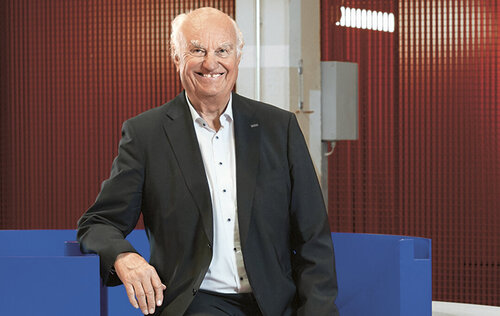Retirement? No way!
Mr. Sommer, a number of major projects – such as Potsdamer Platz in Berlin and the Mercedes-Benz Museum in Stuttgart – bear your hallmark. Are there any projects that you are particularly proud of?
Hans Sommer: My goal for every project I have worked on has been to develop an innovative and cost-efficient building for the customer. And I always had a focus on future-oriented work environments and – to an ever-greater extent – on the reduction of energy consumption. I am particularly proud of two buildings that are not all that big.
Which ones are they?
Back in 1990, I designed our first office building – OWP13 – at Obere Waldplätze 13 in Stuttgart-Vaihingen in accordance with what was then a completely new principle of hybrid offices with a transparent office landscape. Thanks to excellent insulation, we achieved low energy consumption in winter using little technology and with the help of thermal component activation. In summer, intelligent natural ventilation based on the principle of Persian wind towers provides cooling. Ten years later came our next office building at Obere Waldplätze 11 – OWP11. It is regarded as the first low-energy office building in Germany, and I designed it in 2000 with Eberhard Oesterle, Michael Bauer and other experts from Drees & Sommer.
An energy-saving building with pioneering new work environments: OWP13 set new standards for sustainability and productivity-enhancing office landscapes as early as 1990.
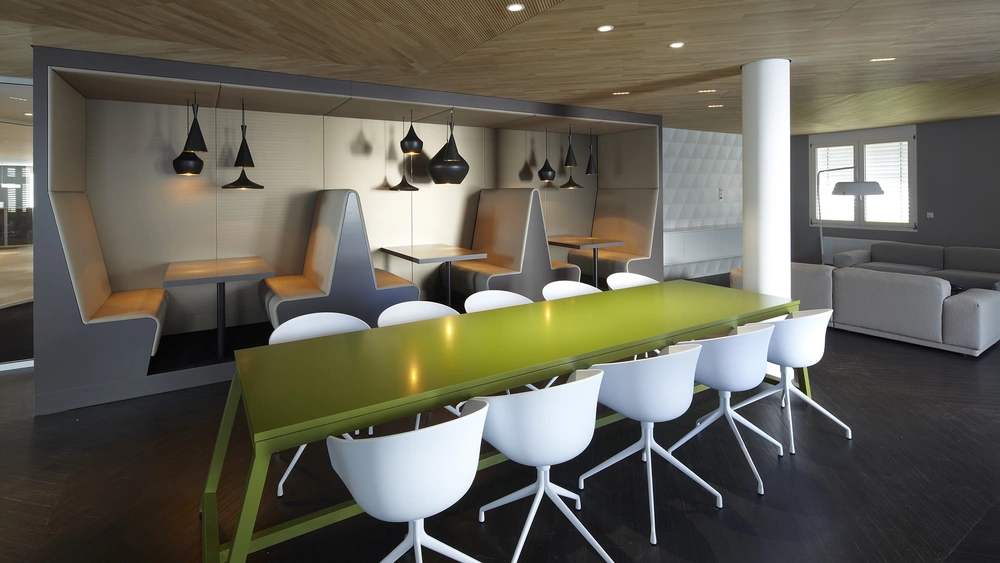


OWP11 was subsequently awarded gold and platinum multiple times by the German Sustainable Building Council (DGNB), an organization that was only founded seven years later. Why was that?
The DGNB made the awards based on the building’s excellent energetic properties due to the use of geothermal energy, the exceptionally high thermal insulation of the building envelope, and the very high level of user comfort. The use of a heat pump and geothermal energy combined with the new principle of component heating in the concrete floor also result in extremely low energy costs. And the building can be cooled very efficiently in summer by reversing the direction of flow and bypassing the heat pump. In the meantime, OWP11 is powered by green electricity and is now actually a zero-carbon building.
And what drove you to do all this?
First of all, the idea of excellent work conditions – both in terms of concept and indoor climate – with no waste of energy. Back in the 1980s and 1990s – and even in the year 2000 – the principle of reducing energy waste was not very widespread. But is more important and topical today than ever before!
This waste of energy is obviously something that bugged you from very early on...
Indeed! I had actually been wondering since the early 1980s about how to design buildings to be intelligent and sustainable in the literal sense of the words – and for me that involved several different aspects. I have always been fascinated by the fact that the Romans’ approach to building was, in many cases, more advanced and sustainable than ours. I gained this insight early in my career from reading parts of the Ten Books on Architecture by Vitruvius. I devoured his works because they contain numerous instructions on modular construction, but also present ideas and building physics specifications for adapting buildings to different climates. And it was always about efficiency.
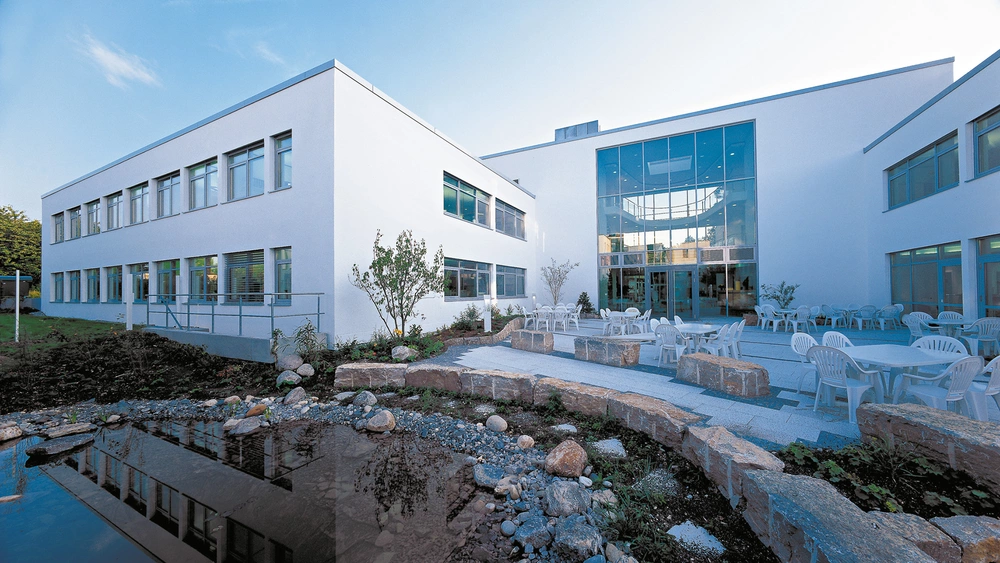
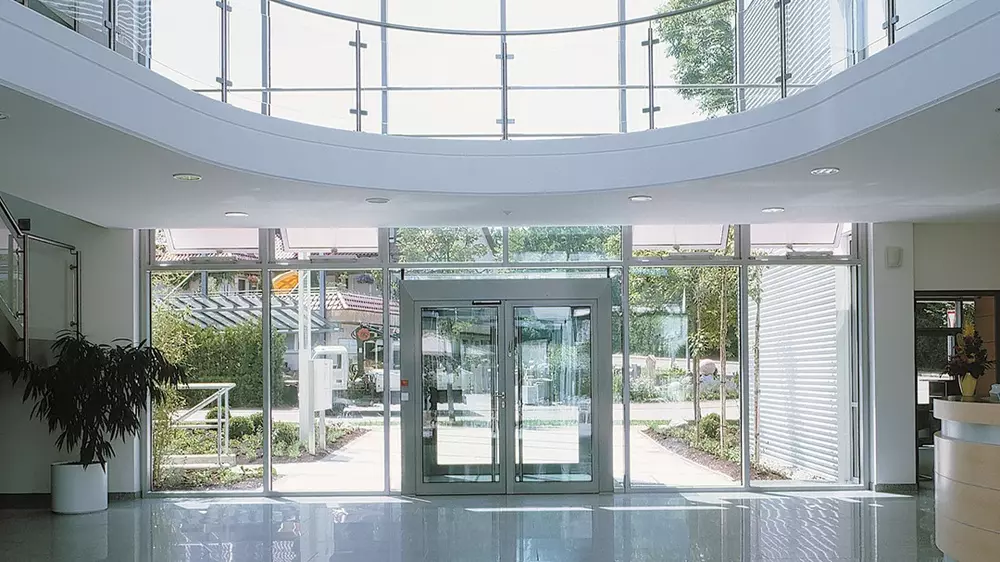
OWP11 is regarded as Germany’s first low-energy office building. In the meantime, the building is powered by green electricity and is now actually a zero-carbon building.
“I was driven by the idea of excellent work conditions – both in terms of concept and indoor climate – without wasting energy.”
How were you able to put your findings into practice?
In the early 1980s, we developed the first simulation programs that could be used to show a building’s energy consumption based on the building envelope and how the building was used. That was revolutionary. It was only through such simulations that people became aware of the huge amount of power required to limit the temperature to a maximum of 22 degrees in summer with the double-duct air conditioning systems popular at the time. So if you wanted to keep operating costs low, you had to implement a range of energy-saving measures.
And how were you able to convince customers?
I realized early on that the owner-occupiers of buildings were less interested in saving on air conditioners than in the associated cost savings. These savings – in other words, the overall cost-efficiency – provided leverage for energy saving up until the 1990s.
How did the situation change then?
From the 1990s onwards, we were increasingly dealing with investors rather than owner-occupiers. The investors were not as interested in saving energy, because the buildings were built for the future users, who then had to bear the costs. This resulted in the construction of many buildings that were primarily intended to impress, with imposing architecture featuring lots of glass, which meant a return to costly air conditioning systems and high energy consumption. But we also developed a strategy to deal with this by making it clear that a building with low energy costs was easier to market than an energy guzzler. We then extended this general idea to the concept of sustainable construction, including to the selection of building materials.
And these features were incorporated into the company’s own buildings at the time?
Yes, absolutely. In the OWP13 and OWP11 projects I mentioned before – but also in major projects such as Potsdamer Platz – the company expanded the principle of sustainability beyond just energy efficiency and developed our own USP with what we call ‘the blue way’.
What does the blue way involve?
Essentially, the blue way involves finding a balance between economy and ecology. Ecological progress is impossible without cost-efficiency.
“Essentially, the blue way involves finding a balance between economy and ecology. Ecological progress is impossible without cost-efficiency.”
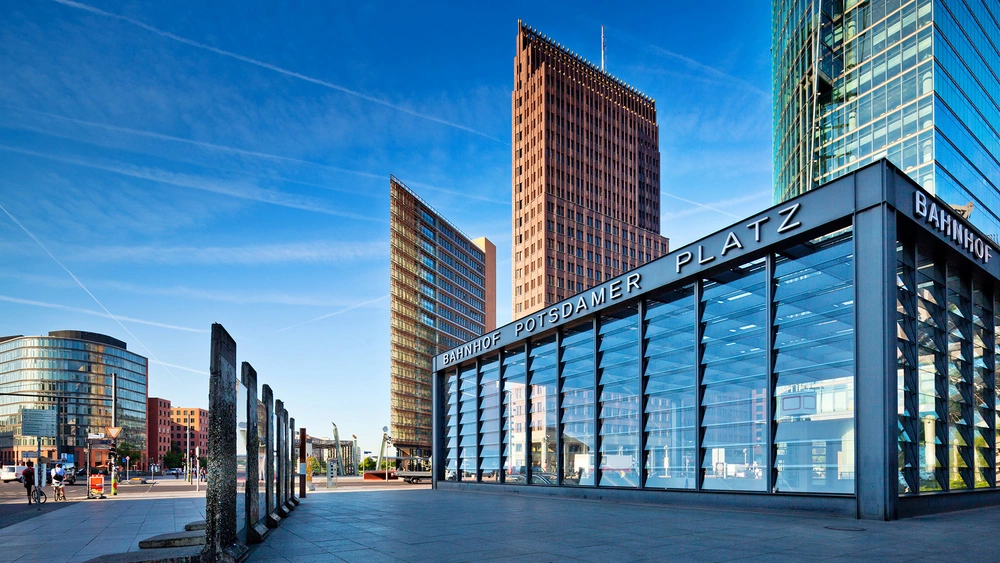
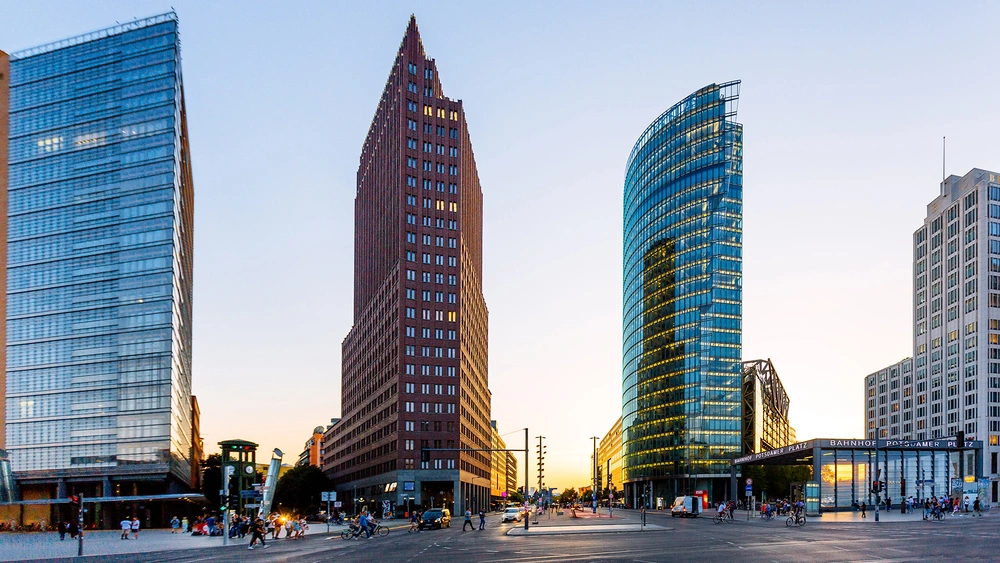
Following the fall of the Berlin Wall in 1989, Potsdamer Platz was completely redeveloped. The former wasteland of the divided city became the new heart of Berlin over the years that followed. In 2011, Potsdamer Platz was the first city district ever to receive the DGNB’s ‘Construction of New Urban Districts’ certificate.
Can you be more specific?
The blue way involves a whole range of measures – from the conservation of energy and material resources to the functionality of the rooms, health-related factors, and process management. And last but not least, social factors – which for me always includes the promotion of art and culture – play a huge role. Today, these would probably fall under the heading ESG. For example, the OWP13 atrium has excellent acoustics. During the design phase, I was influenced by the historic Globe Theatre in London. The artists of the Junge Oper Stuttgart (Stuttgart Young Opera) – and their professional counterparts – have demonstrated the superb acoustics by giving outstanding performances there that have always inspired me. Art, in particular, has so many forms of expression that are indispensable for diversity of opinion and the further development of society. Even back then, I wanted to show that a Blue Building is simultaneously versatile, sustainable and cost-efficient – and that it doesn’t have to restrict esthetic and artistic design.
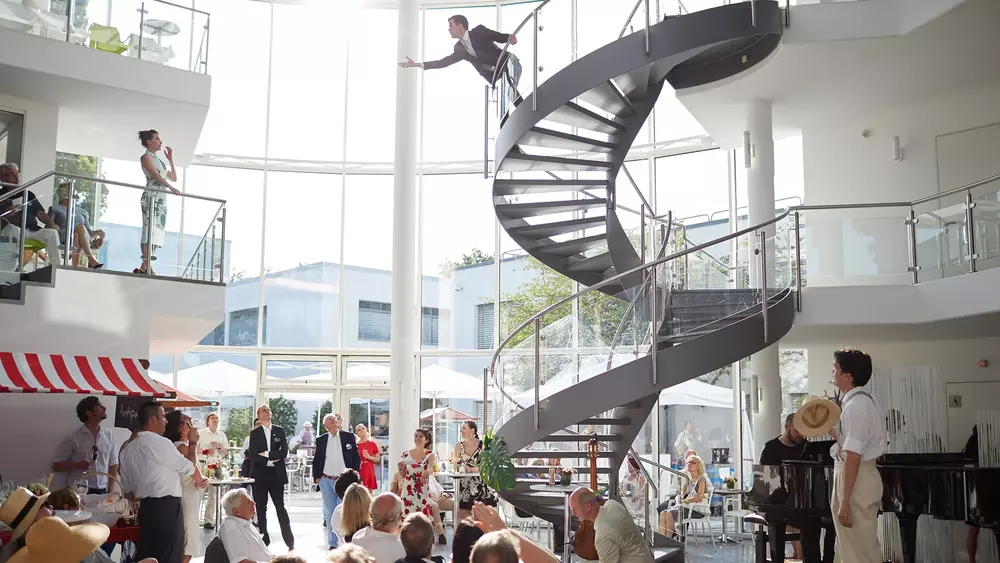
Apropos esthetics: That is a key requirement for the architectural fraternity. You are known as a proponent of modularization. Are you also advocating the end of unique architecture?
No, absolutely not. Unique architecture will remain important, but we have to make it more efficient. By optimizing the geometry and modularizing rooms and structural elements, the complexity of unique buildings can be reduced by up to 80 percent – without having to change the architecture. But in the future, unique buildings will be designed with as many standardized parts as possible. For this purpose, we have developed a customized project kit that contains many elements from a general construction kit. This allows unique buildings to be realized in whole or in part using industrial prefabrication. That’s what’s important to me.
You mentioned Drees & Sommer’s Unique Selling Propositions. To what extent does the company’s corporate structure contribute to these?
Drees & Sommer is managed by Partners who own the company. That makes us independent. For me, this form of organization was logical, as it promotes an entrepreneurial approach on the part of employees. They should be able to make as many decisions as possible themselves and take personal responsibility for them. So self-regulation and an ‘amoeba structure’ – as I call working in small mobile units – are intrinsic parts of the corporate image. And so far we have done very well with this approach. When it comes to employee management, I like to use the transactional analysis approach of “I’m OK – You’re OK”, interacting as equals. I have never adhered to rigid maxims of personnel policy when I found them pointless. Most good people usually have quirks – and I mean that in a positive sense. School grades, whether good or bad, are no predictor of professional success. And outward appearance, such as hair length, does not allow any conclusions to be drawn about managerial ability.
Speaking of managerial qualities, you were assessed by real estate and financial journalists back in 2006. The jury dubbed you ‘Mr. Future’. Do you still see yourself in this role in 2022?
I was never particularly interested in the roles or titles others gave me, even if they were clearly meant as compliments. I can’t help thinking about the future – what challenges will come and how we can solve them. So I was concerned about intergenerational equity and climate change at a very early stage. We are all too defensive and too indecisive on these matters. And that’s why I focus on all aspects of the energy transition, a process we have to accelerate.
“Unique architecture will remain important, but we have to make it more efficient.”
Which aspects do you consider essential when it comes to the energy transition?
The current energy shortage is triggering further energy conservation, but also new, sustainable energy production. At last, the majority of politicians are convinced that we need not just wind turbines and photovoltaic systems, but also an economically viable hydrogen economy! And that will require us to take an international – even global – approach. Germany will always remain an importer of energy – even in the age of renewables. So what does this mean? How can our economy seize opportunities to be at the forefront of technology?
I will engage intensively with these and other topics. And Drees & Sommer will initiate an energy transition conference in 2023, which I am co-designing. I am very much looking forward to that and many other activities.
Prof. Dr.-Ing. Hans Sommer
Born in 1941, Hans Sommer studied civil engineering and architecture at the University of Stuttgart. After working as a structural and design engineer at Baresel AG in Stuttgart, he joined the engineering office Drees, Kuhne u. Partner in 1971, which became Drees & Sommer GbR (civil law partnership) in 1976. From 1984, Hans Sommer was the main shareholder of the GbR, which, together with the respective managing directors, had a holding of at least 50 percent in the regional companies. After company changed its form from a civil law partnership to Drees & Sommer AG (public limited company) in 1992, he was the main shareholder and Chairman of the Executive Board.
In 1999, all regional managing directors of the Drees & Sommer Group consolidated their shares under the AG. The consortium and the Drees & Sommer Partnership were established as the legal framework. In 2008, Hans Sommer relinquished his position on the Executive Board and took over Chairmanship of the Supervisory Board until the end of 2022. The company has been operating as Drees & Sommer SE since 2018.
The key aspects of his work have included content project management, digitization, integration of future-oriented and sustainable planning services as well as the management of major building construction and infrastructure projects. He has published numerous essays and books on these subjects, including his 1983 dissertation on cost control using the cost element method.
Hans Sommer was appointed an honorary professor at the University of Stuttgart in 1986, is a member of the Board of Trustees of the Fraunhofer Institute for Industrial Engineering IAO, and has also been a innovator for the implementation of the energy transition and the hydrogen economy since 2011.

